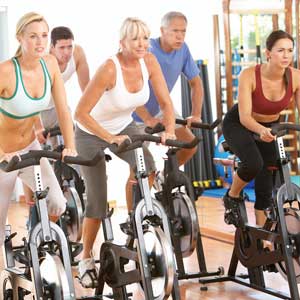Be Intensely Fit!

Why is intensity so crucial in order to lose weight and improve cardiovascular fitness?
The optimum exercise intensity for fitness improvement is in the range of about 50 percent to 85 percent of maximum oxygen consumption. This means that during cardiovascular or aerobic exercise such as jogging, walking, or biking, your heart must beat in the range of 50 to 85 percent of its highest maximum rate—the highest rate at which the heart can pump blood to your body.
The maximum heart rate is a number related to your age. As we age, our hearts beat slower. To figure out your maximum heart rate, subtract your age from the number 220. For example, if you are 40 years old, 220 – 40 = 180. Therefore, your maximal heart rate (MHR) is 180 beats per minute. At a low intensity workout (working out at around 50 percent of your MHR), your heart rate would be 90 beats per minute (bpm). At a high intensity workout (working out at 80 percent) your heart rate would be 144 bpm. So, for a 40-year-old, the exercise target heart rate should be between 90 and 144 bpm. It is important to note that if you are a beginner, you should start exercising at the lower end and work up to the higher intensity as your fitness level improves.
Knowing your target heart rate range and exercising within this range is relevant to your exercise program because if you are always exercising close to the lower end of your heart rate range (or not even in the target heart rate range), you may not improve your fitness level. Also, results such as weight loss are slow as your body is not burning enough calories. This is why some people are not successful at losing weight when they always follow the same routine in which their exercise heart rate is at the low-moderate range of their maximal heart rate.
Portable heart rate monitors are an affordable and easy way to measure heart rate and are available at sporting goods stores. Even though monitoring heart rate during exercise is an excellent method of measuring intensity for the healthy population, it is important to know that certain medications such as beta blockers may lower or alter the heart rate. Therefore, in this situation it may be more difficult to accurately gauge the level of exercise intensity.
An effective alternate method to monitor exercise intensity is to use the Rating of Perceived Exertion (RPE). This is a subjective way of measuring how hard you are exercising and takes into consideration how one is feeling in terms of fatigue, breathing, or discomfort. Use of the heart rate monitor and the RPE Scale is the most effective way to measure exercise intensity so that you can get the most from your cardio workouts. The RPE Scale chart describes the rate of feelings caused by physical exertion. The 0-to-2 category is the amount of energy exerted for instance, if you are sitting watching television or reading a book. Therefore, if you are exercising at this level, the exertion is very weak. The 3-to-4 category provides the feeling of exertion that would be similar to the feeling of a brisk walk to a light jog. In this range, you might get a little out of breath carrying on a conversation depending on your individual fitness level. Beginners should start here.
It is vital to note that along with intensity, duration and frequency of exercise are equally significant when it comes to achieving cardiovascular fitness. Finally, remember that the heart is a muscle and has the capability to grow stronger just like any other muscle of the body—so increase the intensity and challenge it!
Please note: It is important to get a complete physical before beginning an exercise program as certain medical conditions and medications can alter the heart rate. The information provided above is for healthy populations. If you have any known medical problems, are on medication, or have never exercised before and want to begin, please consult your physician first.
[Aarti Patel serves as the columnist for Fitness Lifestyle. She has a B.Sc. in Health Information Administration and is certified by the American Council on Exercise as a Personal and Group Fitness Instructor, and Lifestyle and Weight Management Coach. She can be reached at (404)-376-5655; info@aartifitness.com. This column rotates monthly along with the Ask the Doctor column by Gulshan Harjee, M.D.]
Enjoyed reading Khabar magazine? Subscribe to Khabar and get a full digital copy of this Indian-American community magazine.
blog comments powered by Disqus










